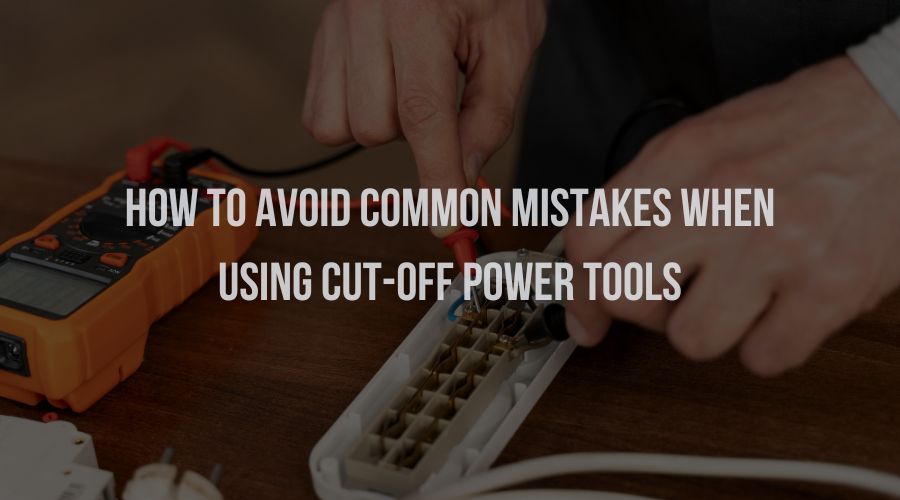Introduction
In the world of construction and engineering, the efficient and precise cutting of materials is paramount. This is where power tools, such as cut-off power tools, come into play. HR Tools & Engineering, a leading power tools manufacturer and supplier, recognizes the importance of these tools in various industries. However, as with any powerful equipment, there are common mistakes that users should be aware of to ensure safety and optimal performance.
Choosing the Right Tool and Blade
One of the most fundamental steps in avoiding mistakes with cut-off power tools is selecting the right tool and blade for the job. HR Tools & Engineering offers a range of hand tools and power tools to cater to different needs. However, choosing the wrong tool or blade can lead to accidents and subpar results.
For instance, if you’re cutting metal, make sure to use a cutting wheel specifically designed for metal applications. Attempting to use a wood-cutting blade on metal is not only inefficient but can also result in damage to the blade and the material, as well as increased safety risks.
Furthermore, the compatibility of the hand tool and the blade should be confirmed. Ensure that the blade size, arbor size, and maximum RPM (Revolutions Per Minute) ratings match the specifications of your cut-off machine. Using an ill-fitting blade can lead to wobbling, vibration, and potential accidents.
Safety Gear Is Non-Negotiable
Safety should always be the top priority when using power tools. Regardless of whether you are a professional in the construction industry or a DIY enthusiast, wearing the appropriate personal protective equipment (PPE) is non-negotiable.
When working with cut-off power tools, consider the following safety gear:
1. Safety Glasses
Protect your eyes from sparks, debris, and flying particles.
2. Hearing Protection
Reduce the risk of hearing damage due to the high noise levels generated by power tools.
3. Dust Mask
Prevent inhaling harmful dust and fumes produced during cutting, especially when working with concrete or masonry.
4. Appropriate Clothing
Wear long-sleeved shirts, long pants, and sturdy work boots to protect your skin from sparks and sharp edges.
HR Tools & Engineering, as a power tools manufacturer and supplier, understands the importance of providing not only quality tools but also promoting safety through the use of proper safety gear.
Blade Installation and Maintenance
Proper blade installation is another critical factor in preventing accidents and ensuring the longevity of both the tool and the cutting accessory. Follow these steps for correct blade installation:
1. Turn Off and Unplug the Tool
Before installing or changing the blade, make sure the power tool is turned off and unplugged to prevent accidental starts.
2. Inspect the Blade
Examine the blade for any signs of damage or wear. Replace it if you notice any issues.
3. Follow the Manufacturer's Instructions
Consult the tool’s user manual for specific instructions on blade installation. Tighten the blade securely using the appropriate tools and techniques.
4. Check Blade Direction
Ensure that the blade is installed in the correct direction as indicated by the arrow on the blade.
Regular maintenance of your cut-off power tool and blades is also essential for safe and efficient operation. Keep the tool clean, lubricate moving parts, and inspect the blade for wear and tear before each use.
Proper Technique and Operation
Mastering the proper technique for using cut-off power tools is crucial to avoid common mistakes. Here are some tips for safe and effective operation:
1. Secure the Workpiece
Use clamps or a vise to secure the material you’re cutting. This prevents movement and reduces the risk of accidents.
2. Stable Stance
Maintain a stable and balanced stance while operating the tool. Keep your feet apart and distribute your weight evenly.
3. Avoid Overloading
Do not force the tool through the material. Allow the tool to cut at its own pace, applying steady, even pressure.
4. Maintain Control
Keep a firm grip on the tool, and be prepared for any unexpected movements or vibrations.
5. Mind the Sparks
Sparks generated during cutting can be dangerous, especially near flammable materials. Ensure you are working in a safe environment and have a fire extinguisher on hand if needed.
6. Maintain a Safe Distance from Edges
Avoid cutting too close to the edge of the material to prevent binding, kickback, or blade breakage.
Environmental Considerations
In addition to personal safety, consider the environmental impact when using cut-off power tools. Some materials, such as concrete, generate a significant amount of dust when cut. To minimize dust exposure and promote a healthier work environment:
1. Use Dust Control Measures
Consider using a dust extraction system or a wet cutting method to capture and contain dust and debris.
2. Work in a Well-Ventilated Area
If you’re working indoors, ensure adequate ventilation to dissipate dust and fumes.
Conclusion
Cut-off power tools are indispensable in many industries, including construction, metalworking, and woodworking. As a trusted power tools manufacturer and supplier, HR Tools & Engineering emphasizes the importance of using these tools safely and efficiently.
By selecting the right tool and blade, wearing the necessary safety gear, properly installing and maintaining your equipment, and mastering the correct technique, you can avoid common mistakes when using cut-off power tools. Remember that safety should always be your top priority, and it’s essential to follow the manufacturer’s guidelines for each tool and accessory.
Whether you’re a professional tradesperson or a DIY enthusiast, the proper use of cut-off power tools ensures not only a successful outcome but also a safe and productive work environment.
